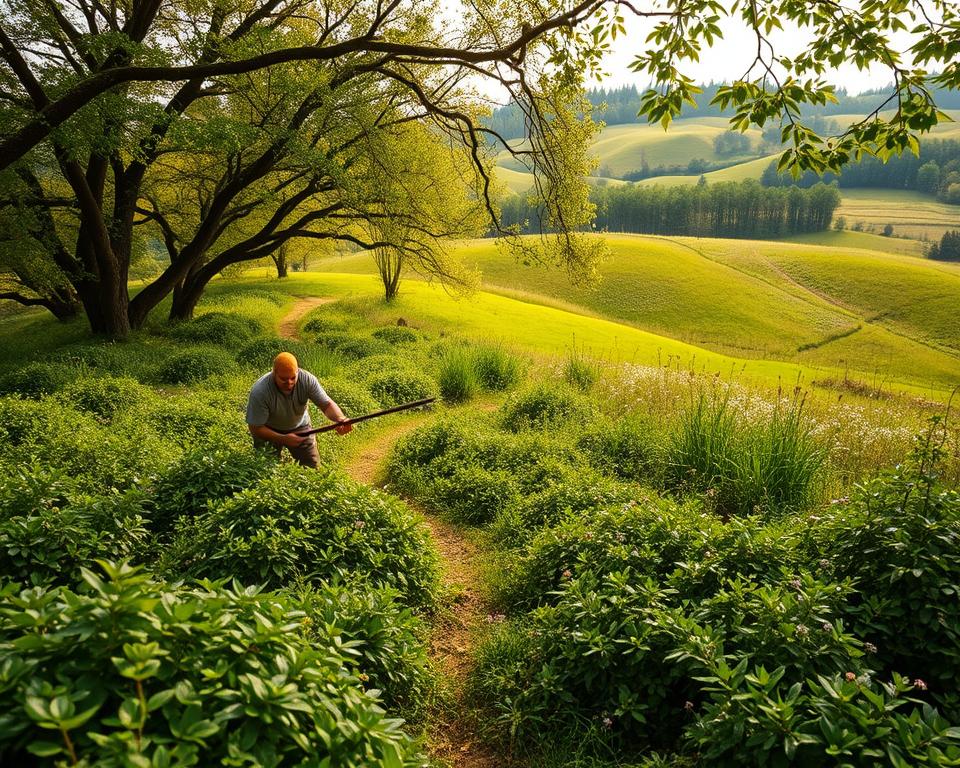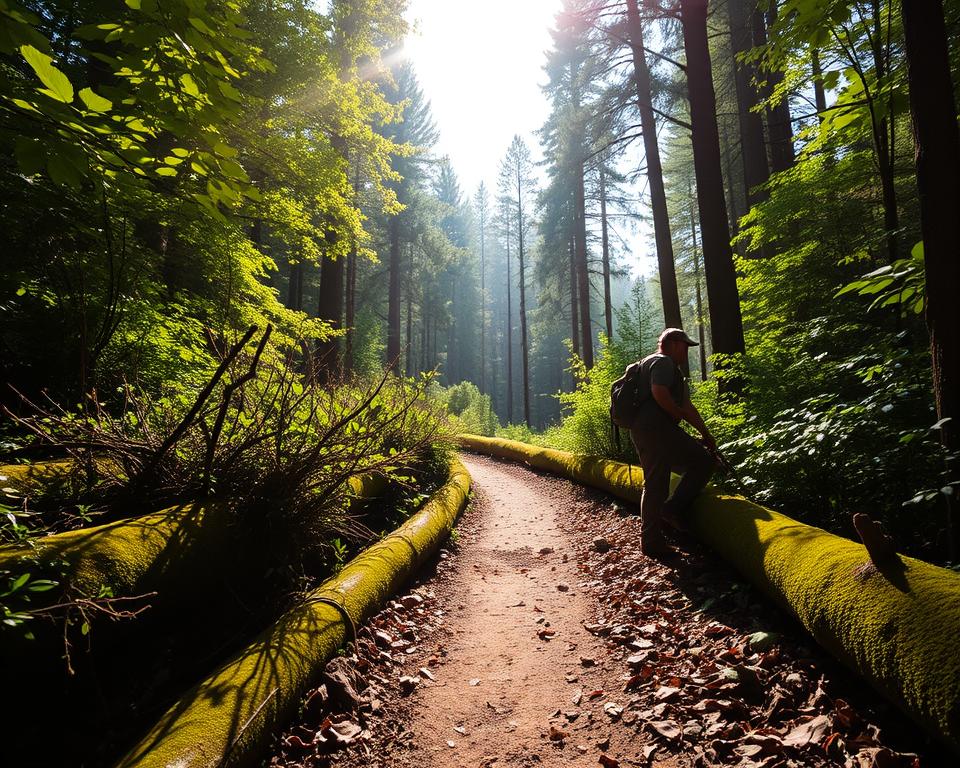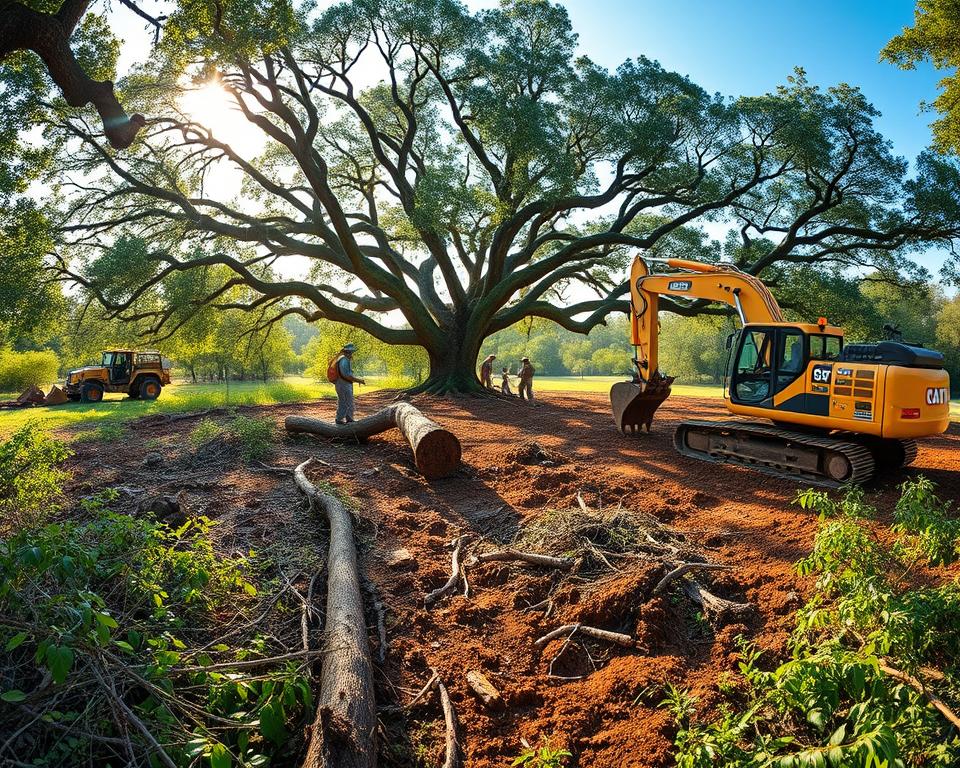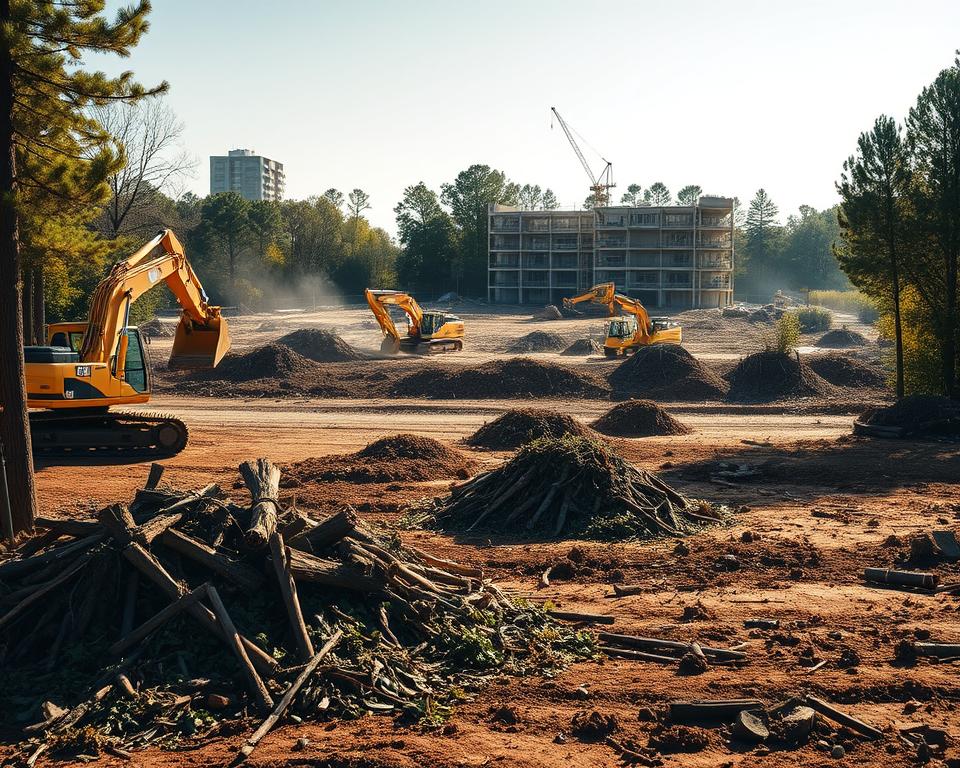Expert Advice: Establish Trails in Forest Grounds
Did you know approximately 80% of homeowners with woodland property hardly venture beyond their lot? That figure highlights the essential need for efficient trail opening and maintenance. Opening paths and trails in wooded areas not only enhances reachability but also enhances safety and wayfinding. This piece will explore expert techniques and perspectives from experienced trail builders.
These experts will provide how to craft well-designed trails that maximize your outdoor area’s usefulness while maintaining its environmental integrity. Discover the key factors for forestry mulching near me and approaches for efficient wooded property maintenance services. These can render your experience through your natural environment more enjoyable.
Main Insights
- Comprehending the value of opening paths for reach and safety.
- Analyzing location conditions to define the purpose of your trails.
- Utilizing the right equipment for effective path clearing.
- Selecting appropriate ground materials that align with terrain type.
- Adopting eco-friendly practices when opening paths.
- Recognizing frequent errors to avoid during the trail-clearing process.
The Importance of Clearing Paths in Wooded Property
Preserving clear paths in wooded zones is crucial for several reasons. It greatly enhances accessibility, making it simpler to navigate thick foliage. Such capability permits landowners and guests to fully enjoy the landscape. This clearing also facilitates various activities like walking, bird watching, or simply enjoying nature.
Boosting Access
Clear paths do more than just enable travel; they also strengthen our link with nature. By improving access, owners open up the open air to a wider audience. Such benefits is useful for personal use or community events, encouraging discovery and appreciation of the environment.
Ensuring Security and Wayfinding
The significance of security on woodland trails is paramount. Defined routes offer straightforward wayfinding and minimize risks from rough ground, hidden obstacles, or sudden plant growth shifts. Landholders invest in creating safe routes, increasing assurance in outdoor adventures.

Planning a Trail in the Woods
Successful trail design requires a deep knowledge of the landscape. It is about assessing terrain and location conditions. Knowing the trail’s goal is also key, as it shapes construction and maintenance.
Evaluating Terrain and Site Conditions
When assessing ground, multiple factors are essential. They include:
- Ground compositions that affect water flow and steadiness
- Incline angle impacting ease of access and safety
- Current plant life that may require clearing or protection
By assessing these factors, trails can withstand different weather conditions. Such routes also support regular pedestrian use. Such planning ensures the trail is durable and respects the ground’s original characteristics.
Defining Your Trail’s Purpose
Path design achievement relies on a clear objective. Consider the activities the trail will support, such as:
- Recreational walking and nature enjoyment
- Access for maintenance or ground management
- Opportunities for wildlife observation and education
Knowing the path’s purpose guides many decisions. This includes the trail’s width and building supplies. Identifying the trail’s goal is vital for crafting a path that meets its needs.
Tools Needed for Trail Clearing
Effective trail opening requires the right gear for various jobs. The correct equipment increase productivity and safety, streamlining the process. The choice between manual tools and motorized equipment varies with the project’s size, ground, and amount of debris.
Essential Hand Tools
Manual implements are key for accuracy and flexibility in clearing overgrown zones. Crucial tools include:
- Loppers: Ideal for slicing thick limbs and bushes.
- Handsaws: Ideal for precision slicing on trees.
- Digging tools: Handy for excavating and creating drainage ditches.
Such instruments offer a hands-on approach, essential for sensitive spots where heavy equipment could damage.
Power Equipment for Efficiency
For big path clearing projects, motorized devices are a major advantage. Such equipment make the task faster and more efficient. Key equipment include:
- Chain saws: Perfect for cutting down large trees and slicing dense undergrowth.
- Brushcutters: Quick for removing thick grass and smaller shoots.
Motorized tools reduces clearing duration, making it suitable for extensive zones. Secure operation is imperative to prevent accidents.
Strategies for Clearing Paths and Trails in Wooded Property
Opening paths and trails in wooded grounds requires careful preparation. It is vital to mediate practicality with sustainability. Efficient plant control ensures the environment’s balance while establishing functional pathways. This equilibrium is crucial to a pleasant exterior encounter.
Clearing Overgrowth and Vegetation
Selective clearing methods are essential when tackling excess vegetation. Manual implements allow for accurate extraction of undesirable vegetation without harming the habitat. Such approach promotes the flourishing of desired species while restraining invasive species. Regular maintenance stops resurgence, improving trail safety and ease of travel.
Creating a Sustainable Pathway
A sustainable path design is more than just looks; it involves choosing materials that minimize erosion and enhance drainage. These strategies honor the natural landscape and lessen ecological impact. Employing native stones or reclaimed wood bolsters long-term sturdiness and environmental balance. Thoughtful design strikes a balance between usability and eco-protection.
Selecting Ideal Trail Surfaces
Selecting the right trail covering is critical for both functionality and durability. The choice between organic and man-made coverings impacts upkeep, user experience, and trail longevity. Knowing the various options and their fitness for your ground is crucial to creating an optimal path.
Organic versus Synthetic Trail Covers
Organic ground covers, such as gravel, broken rock, or wood chips, are often less costly. They integrate well with the surroundings, allowing drainage and a natural appearance. In comparison, man-made surfaces like masonry tiles are more durable and suitable for intensive traffic. Each type has its benefits and disadvantages, based on the planned use and climate factors.
Choosing the Right Materials for Your Terrain
Selecting the suitable materials involves evaluating soil type, drainage needs, and budget. Here’s a simple guide to common materials:
| Material | Advantages | Disadvantages | Cost per Square Foot |
|---|---|---|---|
| Gravel | Affordable, Good drainage | May need frequent replenishing | $1 – $3 |
| Crushed Stone | Stable surface, Organic appearance | Potentially slippery when wet | $2 – $5 |
| Wood Chips | Environmentally friendly, Comfortable to walk on | Requires regular replenishment | $1 – $2 |
| Concrete Pavers | Tough, Low maintenance | Higher upfront cost | $5 – $15 |
Carefully selecting trail surface materials ensures your routes are practical and compliment the area’s natural beauty.
Building Bridges and Turnpikes
Creating trails in wooded grounds requires thoughtful consideration of level shifts. This is crucial for smooth crossings across different landforms and ensuring path usability over time. Constructing overpasses for trails is often required, mainly when crossing wet areas or low-lying ground.
Identifying When to Add Height Variations
Height in path design is often due to uneven landscapes. Major drops or rises require structures like overpasses or raised walkways to maintain path integrity. This method aids prevent ground washout and maintains security, vital for both casual hikers and serious outdoor enthusiasts.
Materials for Building Bridges Over Wet Areas
The selection of supplies for elevated walkways and overpasses is critical for their security and durability. Logs, masonry units, or treated lumber can offer the necessary support against weight and environmental factors. It’s crucial to select materials that are moisture-proof to prevent degradation and allow subsequent modifications.
Trail Maintenance and Upkeep
Maintaining trails safe and open requires ongoing care. Regular checks help identifying issues early, making sure visitors have a positive experience. It’s vital to maintain paths seasonally, as weather changes can impact them. This part will discuss a comprehensive maintenance checklist and the benefits of employing expert trail maintenance services.
Year-Round Upkeep Tasks
A thorough checklist helps path custodians keep their trails in top condition year-round. Key activities include:
- Removing debris such as fallen branches and leaves.
- Checking path layers for wear and tear, following bad weather.
- Assessing drainage systems to avoid flooding.
- Fixing soil washout by supplementing gravel as needed.
- Updating markers and signs for straightforward navigation.
Professional Trail Maintenance Services
For those requiring expert assistance, professional trail maintenance services are a excellent choice. They provide:
- Comprehensive path evaluations by experienced experts.
- Specialized restoration and renewal of busy paths.
- Employing dedicated machinery for better path treatment.
- Applying sustainable practices to prolong path longevity.
Engaging expert path care saves time for other outdoor pursuits. It also introduces expert skill.
Beautifying Trail Borders
Landscaping is crucial to rendering trails visually appealing. By carefully choosing flora and materials, you can create an welcoming environment. This not only draws visitors but also supports local habitats. The right plants for paths provide beauty and sustain environmental stability.
Adding Plants for Attractiveness
When designing pathside planting, picking the appropriate plants is essential. Local species are perfect as they organically blend with the surroundings. They need less maintenance and offer habitat for local fauna. Mix flowering plants, bushes, and turf for a diverse, appealing ambiance around paths.
Employing Borders and Rock Edges
Edging materials like stones and pavers are important for path form. They outline the path and contribute to its aesthetic. These materials prevent soil erosion and provide a clean border with vegetation. Using varied textures and hues can make the path more interesting.
Environmental Considerations in Trail Clearing
Path clearing projects should prioritize environmental sustainability. Sustainable land management methods help protect the site’s ecological integrity. This approach ensures paths harmonize with the natural world harmoniously.
Sustainable Practices for Land Management
Adopting eco-conscious approaches in path clearing is essential. Minimal-impact techniques reduce soil erosion and protect ecosystems. Selective clearing and eco-friendly supplies minimize damage.
Understanding the terrain and vegetation is crucial. It aids ethical clearing and enhances path functionality.
Effect on Fauna and Flora
Fauna evaluations are vital in trail construction. They assist gauge the project’s effect on local fauna and plants. This permits for necessary adjustments before construction starts.
Spotting sensitive species’ habitats avoids ecosystem disturbance. This equilibrium guarantees a healthy ecosystem for every form of life.
Trail builders can design eco-friendly pathways with careful preparation. This focus to eco-friendly practices and wildlife well-being enhances outdoor experiences. It balances leisure pursuits with eco-protection.
Common Mistakes to Avoid While Trail Clearing
Participating in trail opening requires steering clear of frequent errors to prevent long-term issues. Identifying these errors allows for better planning and execution. By emphasizing straightforward path design and addressing drainage, one can prevent extensive maintenance needs.
Overengineering Trail Layouts
Trail management often succumbs to the trap of over-complicating path design. Numerous users believe elaborate designs render trails more attractive. However, simplicity is often the secret to effectiveness. Simple paths improve wayfinding and upkeep, reducing hurdles.
Unnecessary turns and elaborate elements can cause path mistakes. These errors complicate utilization and wayfinding, making paths less enjoyable.
Ignoring Drainage Needs
Neglecting drainage challenges in trails can have severe outcomes. Adequate water management avoids logging, which can erode paths and damage landscapes. Adequate water control measures are essential for a durable trail.
Ensuring proper runoff from the path protects the route and preserves the environment. This allows for a more pleasant nature excursion.
In Summary
Trail clearing is essential for those who desire to fully appreciate their forest properties. It improves accessibility and safety, making outdoor spaces enjoyable for all. Woodland paths provide more than just beauty; they offer chances for leisure and learning about the ecosystem.
Successful planning and execution are key in path clearing. Evaluating ground and choosing the proper materials are essential for creating durable paths. Ongoing upkeep keeps these paths safe and open, promoting a ongoing link with nature.
By understanding the concepts outlined here, you can design and upkeep trails that serve both functional and leisure needs. Embracing forest paths can turn your property into a sanctuary for exploration, rest, and valuing nature.


